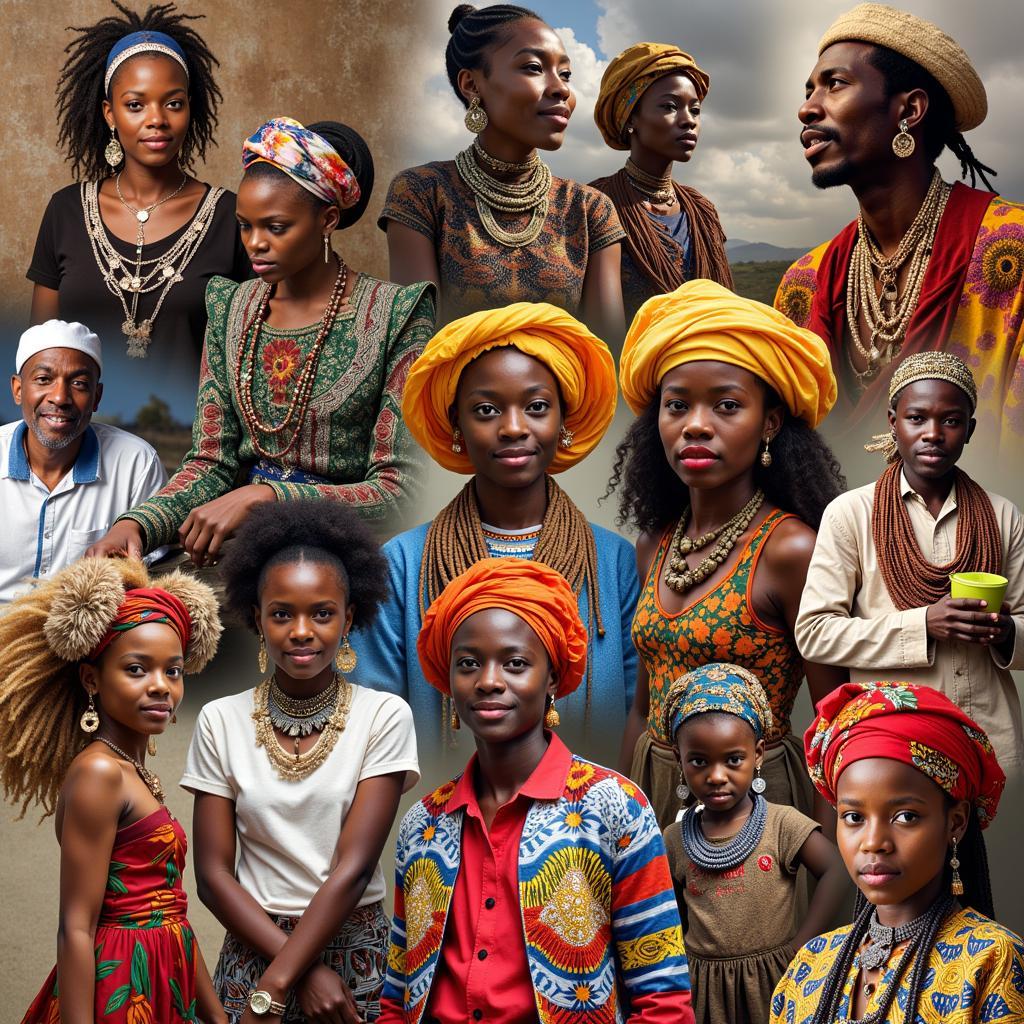A Colorful Journey Through African Clothing History
African Clothing History is a rich and diverse tapestry woven from the threads of tradition, innovation, and cultural exchange. From the vibrant patterns of West African kente cloth to the intricate beadwork of the Maasai, African attire tells a story of identity, status, and artistry that spans millennia. This journey through time reveals not just the evolution of garments but also the deep-seated cultural significance embedded within each stitch and embellishment.
From ancient times, clothing in Africa has been much more than simply protection from the elements. It has served as a powerful symbol of social standing, tribal affiliation, and spiritual beliefs. Materials, colors, and patterns all held specific meanings, communicating messages within and between communities. The earliest forms of African clothing were often made from readily available natural resources such as animal hides, barkcloth, and woven plant fibers. african clothing history and culture explores this connection in detail. As societies developed, so too did their textile traditions, with techniques like weaving, dyeing, and embroidery becoming increasingly sophisticated.
The Influence of Geography and Climate on African Clothing History
African clothing styles have been significantly shaped by the continent’s diverse geography and climate. In the hot, arid regions of North Africa, loose-fitting garments like the djellaba and burnous provided protection from the sun and sand. Further south, in the humid rainforests of Central Africa, lighter fabrics and simpler designs were favored for comfort and practicality. These regional variations highlight the ingenuity and adaptability of African textile traditions.
What were the earliest forms of African clothing? Early forms often consisted of natural materials like animal hides and plant fibers.
Textiles and Trade in African Clothing History
Trade routes played a crucial role in the development of African clothing history. The introduction of new materials, such as silk and cotton from Asia, and the exchange of techniques and styles with other cultures enriched and diversified African textile traditions. african american clothing history offers a perspective on the transatlantic influence on clothing traditions. The trans-Saharan trade, for instance, brought vibrant dyes and intricate weaving patterns to West Africa, contributing to the development of iconic textiles like kente cloth.
Symbolism and Status in Traditional African Attire
The symbolic meaning embedded in African clothing is profound. Colors often hold specific connotations, with red representing power and vitality, white symbolizing purity and peace, and gold signifying wealth and royalty. Patterns and motifs, often passed down through generations, can tell stories of ancestry, clan affiliations, and spiritual beliefs.
How did colors symbolize status in African clothing? Colors held powerful meanings, with red signifying power, white purity, and gold wealth and royalty.
African Clothing in the Modern Era: A Fusion of Tradition and Innovation
African clothing in the modern era reflects a dynamic interplay between tradition and innovation. Contemporary African designers are drawing inspiration from their rich heritage while incorporating modern cuts, fabrics, and techniques. This fusion of old and new has propelled African fashion onto the global stage, showcasing the continent’s vibrant creativity and cultural pride. african ladies costume highlights the diverse range of women’s attire across the continent. The growing popularity of African fashion blogs and online platforms further amplifies this global reach.
The Rise of African Fashion and Style Blogs
The digital age has played a significant role in promoting African fashion globally. African fashion and style blogs have become important platforms for showcasing the latest trends, celebrating African designers, and sharing the stories behind the clothes. These online spaces provide a vibrant hub for fashion enthusiasts and cultural exchange, further solidifying Africa’s position as a major player in the global fashion landscape.
In conclusion, African clothing history is a testament to the continent’s rich cultural heritage and artistic ingenuity. From ancient traditions to contemporary innovations, African attire continues to evolve, captivating the world with its vibrant colors, intricate patterns, and profound symbolism. Understanding the history of African clothing offers a deeper appreciation for the cultural narratives woven into each garment.
FAQ
- What are some of the most common fabrics used in traditional African clothing?
- How has colonization impacted African clothing traditions?
- What is the significance of Kente cloth in West African culture?
- Are there specific clothing traditions associated with different age groups or genders in African societies?
- How is African fashion being represented on the global stage today?
- What are some key characteristics of North African clothing styles?
- Where can I learn more about the history of African textiles?
Need support? Contact us 24/7: Phone: +255768904061, Email: kaka.mag@gmail.com, or visit us at Mbarali DC Mawindi, Kangaga, Tanzania.

